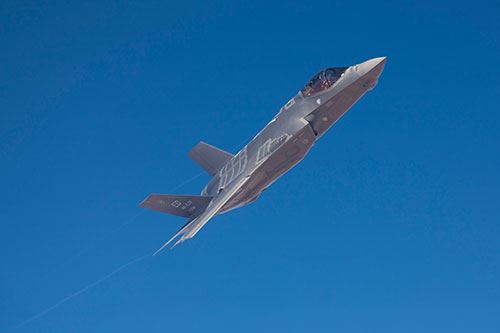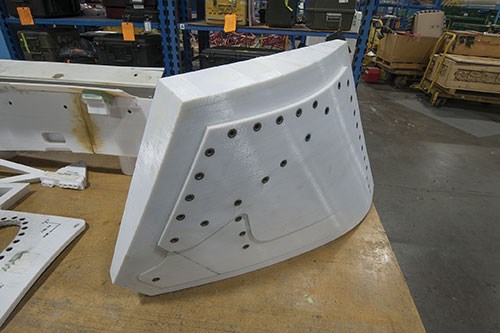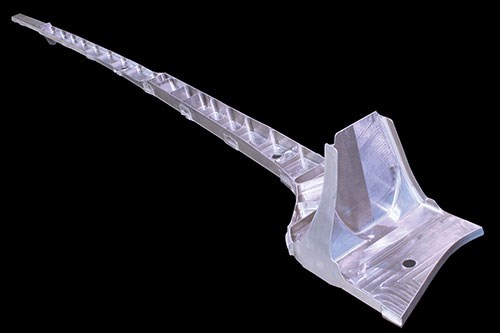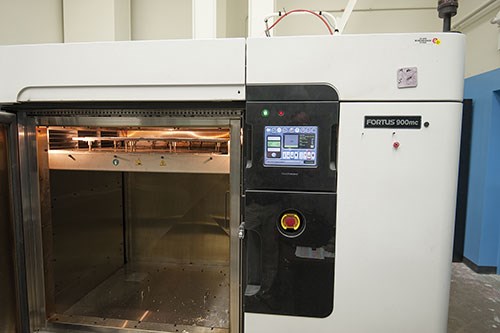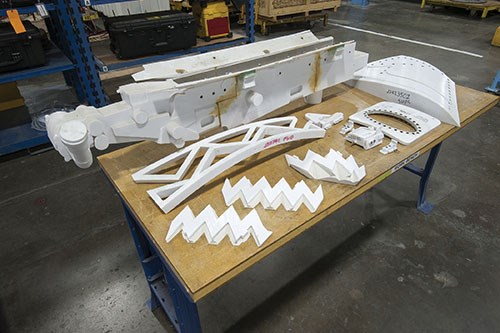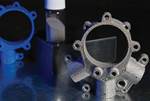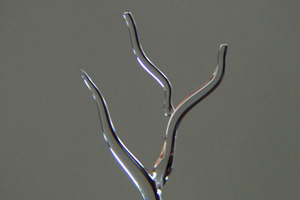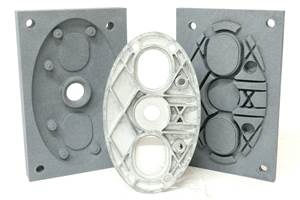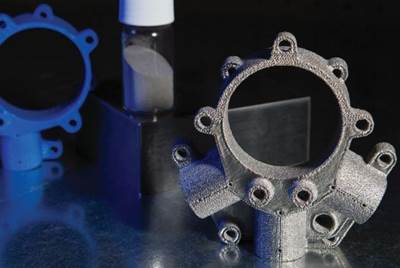Will Additive Manufacturing Play a Major Role in Aircraft Production?
One answer: It already does. Lockheed Martin discusses the challenges and promise of producing parts through 3D printing.
Will additive manufacturing become an accepted and widely used process in aircraft production?
One point of view says the answer is probably yes. Military aircraft maker Lockheed Martin Aeronautics, for example, is working to advance additive manufacturing—the technology of forming parts by laying down material in precise layers. The company is experimenting with aircraft structural components produced through a production additive process, and it foresees considerable improvements in aircraft performance and cost as a result of one day making significant parts of the aircraft with this technology.
However, from another point of view, additive manufacturing is already widely used in aircraft production. After all, part of manufacturing a plane is manufacturing the tooling used to make that plane. Lockheed Martin’s Forth Worth, Texas, production facility currently uses 5,000 jigs and fixtures produced through additive manufacturing. The plant has 18 additive machines from various makers of this technology, and these machines are in use 70 percent of the time producing new or replacement production tooling. When it comes to building this tooling, additive manufacturing is not a leading-edge possibility, but a long-established fact.
This very experience with making and relying on engineered tooling produced additively contributes to the confidence of Lockheed Martin leaders that components of this company’s planes—even flight-critical parts—will eventually be made through additive processes. I had the chance to speak about this with Joseph Rappisi, the company’s VP of aeronautics production operations, and Don Kinard, Ph.D., senior fellow with the company.
Both men make it clear that additive manufacturing is not yet ready for flight-critical parts, and likely will not be ready soon. Comparing today’s additive manufacturing technology with what that technology might plausibly deliver in the future is, in Mr. Rappisi’s words, a matter of comparing “the state of the art versus the art of the possible.” In spite of its limitations today, however, additive manufacturing of aircraft parts is seen as a real possibility, and the company is exploring the potential this possibility might hold not only for its production processes, but also for the design of its planes.
Part of the potential is aircraft that are dramatically less expensive to operate. A plane with major structural members produced through additive manufacturing would be a plane with far fewer fasteners, because additive’s ability to generate complex structures means that structures that are assemblies today might be grown as a single piece. Fewer fasteners means less weight, reducing fuel cost, and also fewer stress points, likely extending the life of the plane. An additively manufactured plane would thus be one with a much lower total cost of ownership.
But again, we’re not there yet, Dr. Kinard says. Some of the requirements are being met. Additive manufacturing technology with the size and speed for mass production of aircraft components is now achievable, for example. Lockheed Martin is experimenting with wing spars and related parts made through electron beam welding, an additive process capable of laying down material quickly. But in terms of metallurgy and material consistency, the seemingly dense metal parts made from this process are not currently capable of passing Lockheed Martin’s engineering requirements, let alone achieving government certification for assembly into a plane.
Porosity is an issue, Dr. Kinard says. The consistency of the electron-beam-welded parts is superior to that of a casting, and could replace a cast part, but an aircraft’s fracture-critical members are not made through casting. “We need to get to the point where we can treat this material like plate or forging,” he says.
Another issue is the cost of the process itself. Even if additive manufacturing does achieve the ability to create forged-like parts, it won’t necessarily do so in a way that is cost-effective compared to forging. Like a forging, the additive part will still require machining to achieve final tolerances. In addition, it might always be the case that additive parts will require heat treating, or hot isostatic pressing (HIP) in the case of additive parts made from powder. That is why he says, “We might discover that additive is cost-effective only for components that can’t be made any other way.”
The ultimate answer to questions such as these is impossible to predict, because both the capabilities and the economics of additive manufacturing are still advancing rapidly. Makers of additive machines are working closely with Lockheed Martin to develop a machine that meets the company’s requirements for this technology, in part because achieving full acceptance in the production of critical aircraft parts would mean the technology was proven and had essentially arrived.
Dr. Kinard says he believes he sees similarity between additive technology and the advance of composites in aircraft manufacturing. His own career in aircraft manufacturing spans 30 years. At the beginning of that career, when aircraft composites were new, he says he might have imagined that we would one day see an all-composites plane. Today, that notion would seem fanciful, yet composites are now accepted and in widespread use in aircraft production. During those 30 years, while composites technology was advancing, industry also figured out where composites both do and do not make sense.
Notably, he says one of the keys to the acceptance of composites was technology for inspecting and certifying parts made with these materials. For additive, that development is still needed. Rather than inspecting the final part, he believes inspection in additive manufacturing will ultimately take the form of monitoring each layer as it is built.
The technology is moving more quickly than composites did, he says. The full arc to additive manufacturing’s maturity likely will not take another 30 years. But there will be a delay. Even after achieving both the capability and the opportunity to introduce an additively fabricated part, getting certification for a primary component made in such a novel way could take an additional 3-5 years.
That delay is good, says Mr. Rappisi. The life of a war fighter, a U.S. military pilot, depends on the integrity of the plane. Thus, it’s fitting that there is redundancy and assurance built into the process for validating that this integrity is there.
“We never forget who we’re working for,” Mr. Rappisi says. Reducing the life cycle cost of the plane is a valuable objective, he notes, but it is not the most important goal.
Related Content
Ice 3D Printing of Sacrificial Structures as Small as Blood Vessels
Using water for sacrificial tooling, Carnegie Mellon researchers have created a microscale method for 3D printing intricate structures small enough to create vasculature in artificial tissue. The biomedical research potentially has implications for other microscale and microfluidics applications.
Read MoreComplete Speaker Lineup Announced for the 3D Printing Workshop at NPE2024: The Plastics Show
Presentations will cover 3D printing for mold tooling, material innovation, product development, bridge production and full-scale, high-volume additive manufacturing.
Read MoreBMW Expands Use of Additive Manufacturing to Foster Production Innovations
The BMW Group is manufacturing many work aids and tools for its own production system using various 3D printing processes, with items such as tailor-made orthoses for employees, teaching and production aids, and large, weight-optimized robot grippers, which are used for such things as carbon fiber-reinforced polymer roofs and entire floor assemblies.
Read MoreFoundry Lab: How Casting in a Day Will Improve the Design of Metal Parts (Includes Video)
The company’s digital casting process uses 3D printing, but the result is a cast part. By providing a casting faster than a foundry, the company says effective prototyping is now possible for cast parts, as well as bridge production.
Read MoreRead Next
Nothing But Design Intent
The way to save cost through additive manufacturing is not only to use it to eliminate unnecessary material, but also to apply it within a process that avoids unnecessary effort and interpretation by keeping all manufacturing information within the digital realm. Lockheed Martin is pursuing this ideal.
Read MorePostprocessing Steps and Costs for Metal 3D Printing
When your metal part is done 3D printing, you just pull it out of the machine and start using it, right? Not exactly.
Read MoreAlquist 3D Looks Toward a Carbon-Sequestering Future with 3D Printed Infrastructure
The Colorado startup aims to reduce the carbon footprint of new buildings, homes and city infrastructure with robotic 3D printing and a specialized geopolymer material.
Read More

